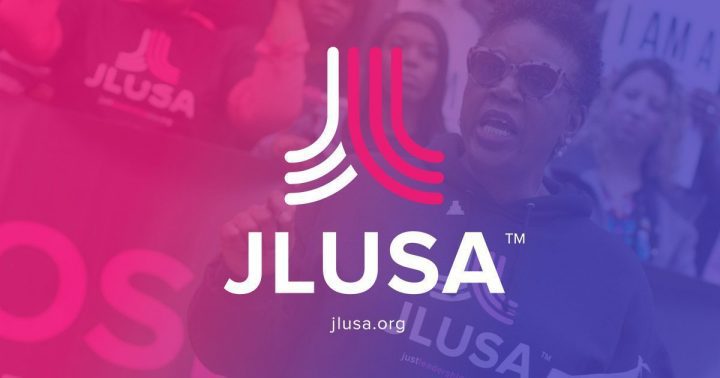
Disclaimer – Auto-generated content in Spanish:
Algunas partes de esta página se generan automáticamente y podrían contener errores menores. Se recomienda usar el juicio crítico al interactuar con ella.
JLUSA believes that movements are strongest when they are organizing, and that the consequent power of mobilizing organized people can best be understood through the lens of movement history, theories of social change, and a wider structural analysis. From the historical lessons of successful and stifled movements alike, we learn that political education can build solidarity among leaders and strengthen our understanding of the forces that create inequality, as well as reveal where there are opportunities for resistance to those same inequalities. On May Day, a day about working people who we know are most powerful when they are organized, we release the first JLUSA reading list to detail the history and struggle of workers in this nation.
Hammer and Hoe: Alabama Communists During the Great Depression, Robin D.G. Kelley, 1990.
In the 1930s, the Communist Party set out to organize tenant farmers in rural Alabama. Instead, tenant farmers utilized the platform of the Communist Party to build powerful resistance to Jim Crow segregation, and in the process reshaped the Party’s tactics, strategy, and ideology.
We Are Not What We Seem: Black Nationalism and Class Struggle in the American Century, Rod Bush, 1999.
A critical examination of the intersections of class struggle and the fight to build Black Power from the turn of the twentieth century through the 1970s. Bush contends that a class analysis, often neglected in Black Power studies, is central to all anti-racist liberation movements.
City of Quartz: Excavating the Future of Los Angeles, Mike Davis, 1990.
A look at the forces of power and influence that shaped Los Angeles’ current political economy. Davis ends with an examination of the city’s future as a site of physical and metaphorical incarceration.
American Babylon: Race and the Struggle for Postwar Oakland, Robert O. Self, 2003.
Self traces the history of Black liberation struggles in Oakland, finding genesis in the demands for economic justice following World War II and the forces that sought to use property and taxation to suppress demands for equality.
They’re Bankrupting Us! And 20 other Myths about Unions, Bill Fletcher Jr., 2012
They’re Bankrupting Us!takes on anti-union propaganda that has been central to destroying organized labor and ensuring the precarity of working-class laborers. A longtime labor leader, Fletcher centers unions as critical to upholding the tenants of democracy.
Golden Gulag: Prisons, Surplus, Crisis, and Opposition in Globalizing California, Ruth Wilson Gilmore,2007.
In response to global and state economic crises, Gilmore argues that amid economic crisis on one hand and the destruction of radical labor on the other, California relied on a gross boom in prison growth to stabilize the economy for corporate entities.
Detroit: I Do Mind Dying: A Study in Urban Revolution, Dan Georgakas and Marvin Surkin, 1975.
Georgakas and Surkin trace the origins and resistance led by the Detroit Revolutionary Union Movement and the League of Revolutionary Black Workers, organizations founded by Black autoworkers in Detroit amid deindustrialization.
How Capitalism Underdeveloped Black America: Problems in Race, Political Economy, and Society, Manning Marble,1983.
Written in 1983, Marable’s seminal text details structural racism, state violence, incarceration and class warfare to extricate the critical forces of repression and resistance in the 20th century.
Pedagogy of the Oppressed, Paolo Friere, 1970.
A formative text that lays out a theory of education and organizing based on the destruction and eventual transformation of repressive structures. Friere situates liberation in collective action and informed unity.
Poor Workers Unions: Rebuilding Labor From Below, Vanessa Tait, 2000.
A powerful account of low-wage workers and their efforts to organize collectively. Tait’s work expands the conceptualization of labor organizing to demonstrate how inextricably bound class is to race, gender, nationality, and citizenship status.
Black Panther Party Ten Point Program, Black Panther Party, 1966.
The Ten Point Program lays out an anti-racist, economic justice platform for Black and Latino communities marginalized by structural oppression and brutality.
Thank you so much for supporting our mission here at JLUSA! Your donation helps to support our network of leaders working to dismantle oppressive systems and uplift people and families impacted by mass incarceration across the country.
All charitable donations made to JLUSA are fully tax deductible, as allowable by the IRS.
Mail that includes checks only:
JUSTLEADERSHIPUSA, INC
P.O. Box 23681
New York, NY 10087-3681
All other mail:
P.O. Box 1730, New York, NY 10037
347.454.2195
© 2025 JustLeadershipUSA. All Rights Reserved.
JustLeadershipUSA® is a non-partisan organization. The views, thoughts, and opinions expressed belong solely to the individual author or speaker, and do not necessarily reflect the official policy or position of the organization.